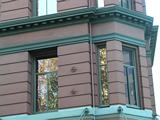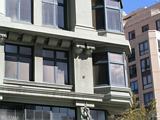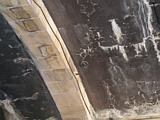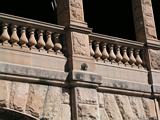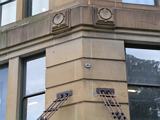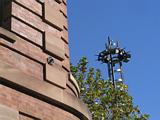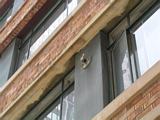Menu

Remnants of the Sydney Trams
There are remnants of the trams everywhere, once you learn how to look.
Here are some examples from the inner and eastern suburbs of Sydney.

|
Tram Tracks Tarred Over |
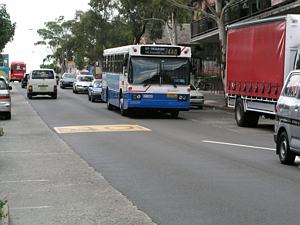
|
Any time you travel along a road that has
bitumen in the middle of the road
and cement at the sides, it's probably an old tram route.
It's everywhere in Sydney's inner suburbs.
This example is in Norton Street,
Leichhardt, just near Marion Street.
|
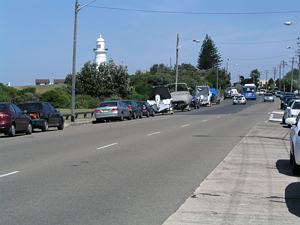
|
The Watsons Bay trams used to run past
the Macquarie Lighthouse at South Head.
|

|
Tram Waiting Sheds |
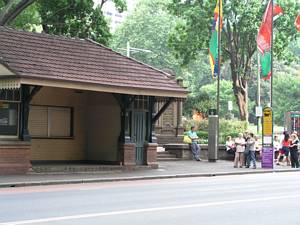
|
Large waiting sheds were erected at many tram stops,
especially where there might be a crowd of shoppers,
or a lot of people going to a sporting event.
These waiting sheds are now very rare and are items of major heritage value.
This shelter in the city at Hyde Park is a well known landmark.
It's now the bus stop for William Street services
at the corner of Park and Elizabeth.
|
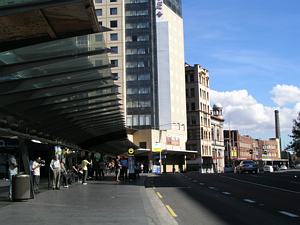
|
There used to be a large tram waiting shed at Railway Square, but nothing remains.
It has been replaced by a weird structure that lets in the rain and the wind
but looks extremely modern.
The original tram shed has been lovingly re-erected at the Loftus Tram Museum.
|
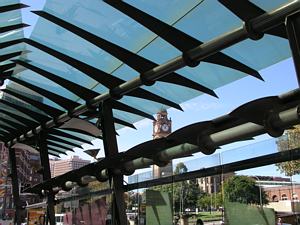
|
A monster has replaced earlier buildings.
Railway Square has been repeatedly modified to cater for
more and more cars and trucks, and to keep pedestrians out of harm's way.
Old photos show people walking in all directions, there was so little traffic.
|

|
Tracks Visible in the Road
|
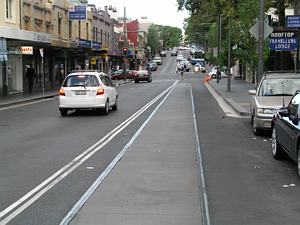
|
These are very rare in Sydney these days,
since all the tracks were quickly taken up or tarred over
once the trams were taken off.
The haste was such that it makes you feel
they knew they had made a terrible mistake.
Here is Glebe Point Road, just near Pyrmont Bridge Road.
The road surface crumbled away and these tram tracks appeared.
Now the City of Sydney Council has
specified that the historic rails stay visible.
|
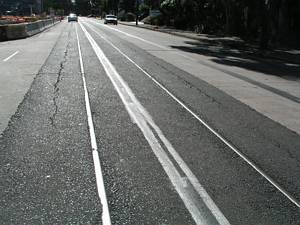
|
This picture, with rails clearly showing, was taken in Zetland
near the Moore Park Supa Centre.
There is just a single track straight down the middle of the road.
It was not a regular tram route, but linked two depots together,
and allowed trams from the inner western suburbs to bring people
over and back for the Randwick Races, the Cricket and the Royal Easter Show.
|

|
Roads Crossing Over Tram Tracks |
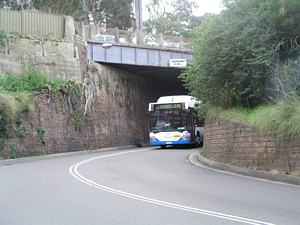
|
Havelock Avenue at South Coogee passes under Brook Street.
This dates from 1901 and was originally "trams only".
|

|
Bridges Just for Trams |
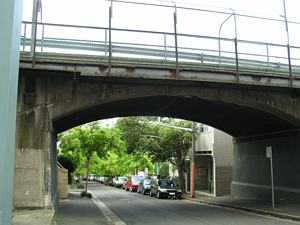
|
This bridge over peaceful Barcom Avenue in Darlinghurst
originally carried trams from 1916 to 1954.
This tram route was called the Bellevue Hill line,
and it ran through Paddington to Bondi via Bellevue Hill.
The footway on this side of the bridge is still known as the Cutler Footway.
Today, the 389 bus follows much of the tram route including this bridge.
|

|
Rounded Corners |
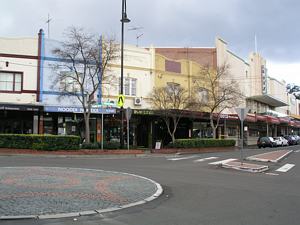
|
All the locals know this place as "The Spot" and it's just a few blocks
south of the Randwick shopping centre.
All Coogee buses go "via The Spot" but in recent years
Sydney Buses have been trying not to say "The Spot"
just in case a few tourists get lost.
50 years ago trams rounded this corner next to the hedges.
|
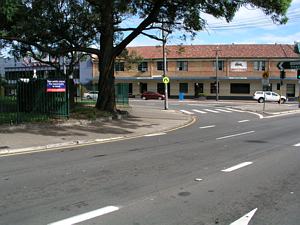
|
This is the corner of Botany Road and Gardeners Road at Mascot.
Some trams coming from the city down Botany Road
did a left turn into Gardeners Road.
The two streets meet at an angle, it's a very sharp corner.
|

|
Trams in Cuttings |
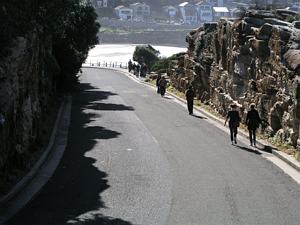
|
Trams ran down to Coogee, Clovelly, Bronte and Bondi beaches.
It was essential to select a gentle route that was not too
steep for the packed trams to climb at the end of a day at the beach.
Railway-style construction was often used in building
the Sydney tram network,
with cuttings through solid rock.
The most famous of all is at Bronte where the tram descended
to a terminus right at the beach and next to a large picnic park.
|
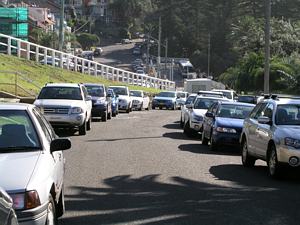
|
The tramway cutting is now used as a long, narrow car park, especially in summer.
You can see a bus at the terminus in the distance.
Bronte beach is on the right and the cafes are on the left.
|
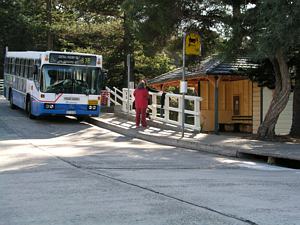
|
The trams have been replaced by the 378/440 bus service
which goes to Railway Square via Bondi Junction and Paddington.
|
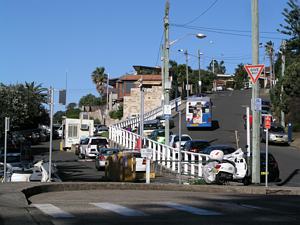
|
A 378/440 bus climbs the hill at the right,
whilst, at the left, the gentle slope
once used by trams is now the car park.
|

|
Trams in Their Own Reservation |
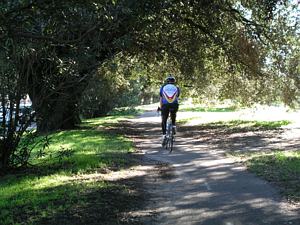
|
This pleasant cycling track is between Centennial Park and Alison Road.
It was once the reservation for the Coogee and Clovelly trams,
running from Anzac Parde up to Randwick TAFE at Darley Road.
What is now called "the bus roadway" along Anzac Parade
was a tram reservation too.
It catered for the Maroubra and La Perouse trams as well as Clovelly and Coogee,
plus special trams to the Cricket Ground,
the old Showground and Randwick Racecourse.
|
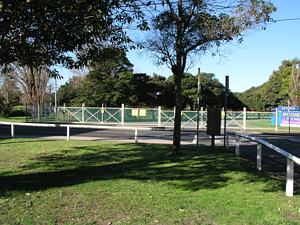
|
These days Abbotford Street, Kensington, is a quiet street.
It's only one block long,
with a very wide centre plot which is now mainly grass and small trees.
In this picture you can see Doncaster Avenue,
with Randwick Racecourse in the background.
From 1907 to 1958, six tram tracks crossed over Doncaster Avenue
and into the racecourse.
Abbotford Street was used to store trams during race meetings.
After the races, trams departed from six platforms for
Central Railway and Circular Quay,
plus special trams to inner western suburbs.
|
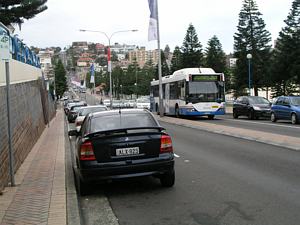
|
Arden Street, Coogee Beach.
Coogee Beach is just to the right of this picture.
Originally there were two tram tracks next to the retaining wall at the left.
The trams ran in their own reservation down to a terminus
at the beach near Dolphin Street.
Now Arden Street is a normal tarred road, open to all traffic.
|
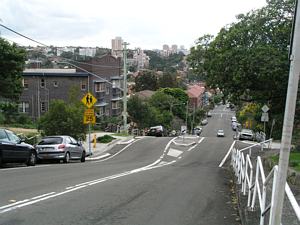
|
Carrington Road runs north-south and is one of the steeper
streets in Coogee.
Here, near Carr Street, there is an extra bump where the tram tracks
crossed the street.
The trams ran in their own cutting as shown in the next picture.
|
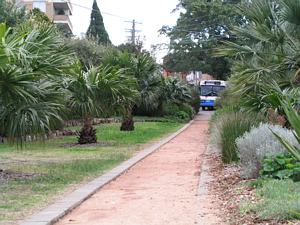
|
Here the bus makes a right turn, whilst the trams used to enter
their own cutting for a gentle descent to Coogee Beach.
The location is at the corner of St Paul Street and Dudley Street,
just down the hill from The Spot.
|
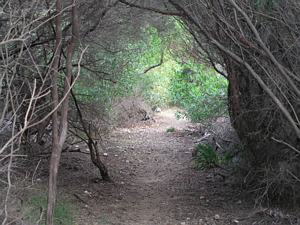
|
It's very overgrown now, but this was once a single tram track
where trams came down the hill to the terminus in Cliff Street
just past at The Gap at Watson's Bay.
Fun to explore.
|

|
Quiet Streets That Once Had Trams |
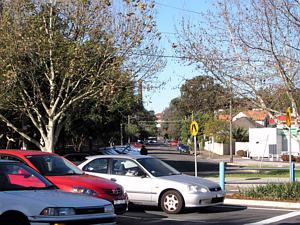
|
This is King Street, Randwick, at the corner
of Darley Road and Alison Road.
The street is closed off now,
but it was once the route for the Randwick/Coogee trams.
The Clovelly trams turned sharp left into Darley Road,
and two more tracks veered across to the left and
into the Randwick Tramway workshops.
The site at the left is now Randwick TAFE,
although a bus is emerging from Randwick bus depot
in the distance.
The only obvious remnant of Sydney's main tramway workshops
for over 50 years is the tall chiminey visible through the trees.
|

|
Clusters of Shops |
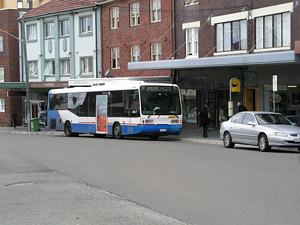
|
This is Havelock Avenue, South Coogee.
This row of shops blossomed to service the Coogee tram route.
Note the tarred over tram tracks in the foreground.
|
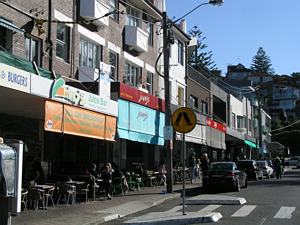
|
Everyone calls this the Bronte Cafes.
This row of shops is right at Bronte beach,
directly opposite where the trams once terminated.
|
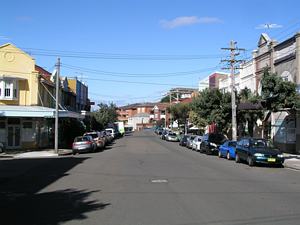
|
Little shopping centres sprang up wherever a tram route terminated
or where there was a lot of regular passengers.
This is Burnie Street, Clovelly.
Buildings in this group are marked 1919, 1920 and 1923.
The tram route to Clovelly Beach opened in April 1913.
Although this street looks as though it must have had trams,
the tram stop was adjacent in Clovelly Road which
at that time was a trams-only reservation below Beach Street.
|

|
Overhead Wiring and Tram Rosettes |
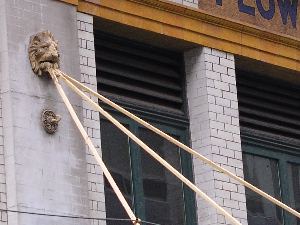
|
All the overhead wiring and power cabling is long gone.
All the signal boxes,
which looked out above the street at major tram junctions
(for example at Railway Square, and City Road at Broadway
and many intersections in the city), are gone.
However the support wires for the live overhead wiring above the tracks
were attached directly to buildings with a large anchor point,
and usually with a decorative rosette.
These rosettes are surprisingly common,
once you get the knack of spotting them.
For the pictures below, click to see the broader location.
|

|
Tram Depots |
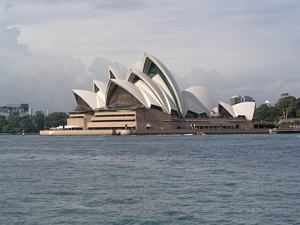
|
Before the Opera House, the Fort Macquarie Tram Depot occupied this site.
It was a huge shed with brick walls,
built like a gothic castle, with fabulous harbour views
and tram tracks everywhere.
Next, the Opera House was a wonderful fantasy from a 1950s Labor
Government who thought the masses should become more cultured.
Especially after they had just destroyed the largest tram network
in the Southern Hemisphere, with transport experts now saying this
was the worst transport planning decision in the history of Australia.
So the Government held huge public lotteries so that the masses would pay
for the culture for the elite.
They pretended that everybody would go to the opera.
The Opera House took 16 years to build,
but is easily one of the best buildings in the world.
You could not dream up a novel like this.
|

Last Updated - 15th August, 2018
Copyright(c)2009-2018.
About





















